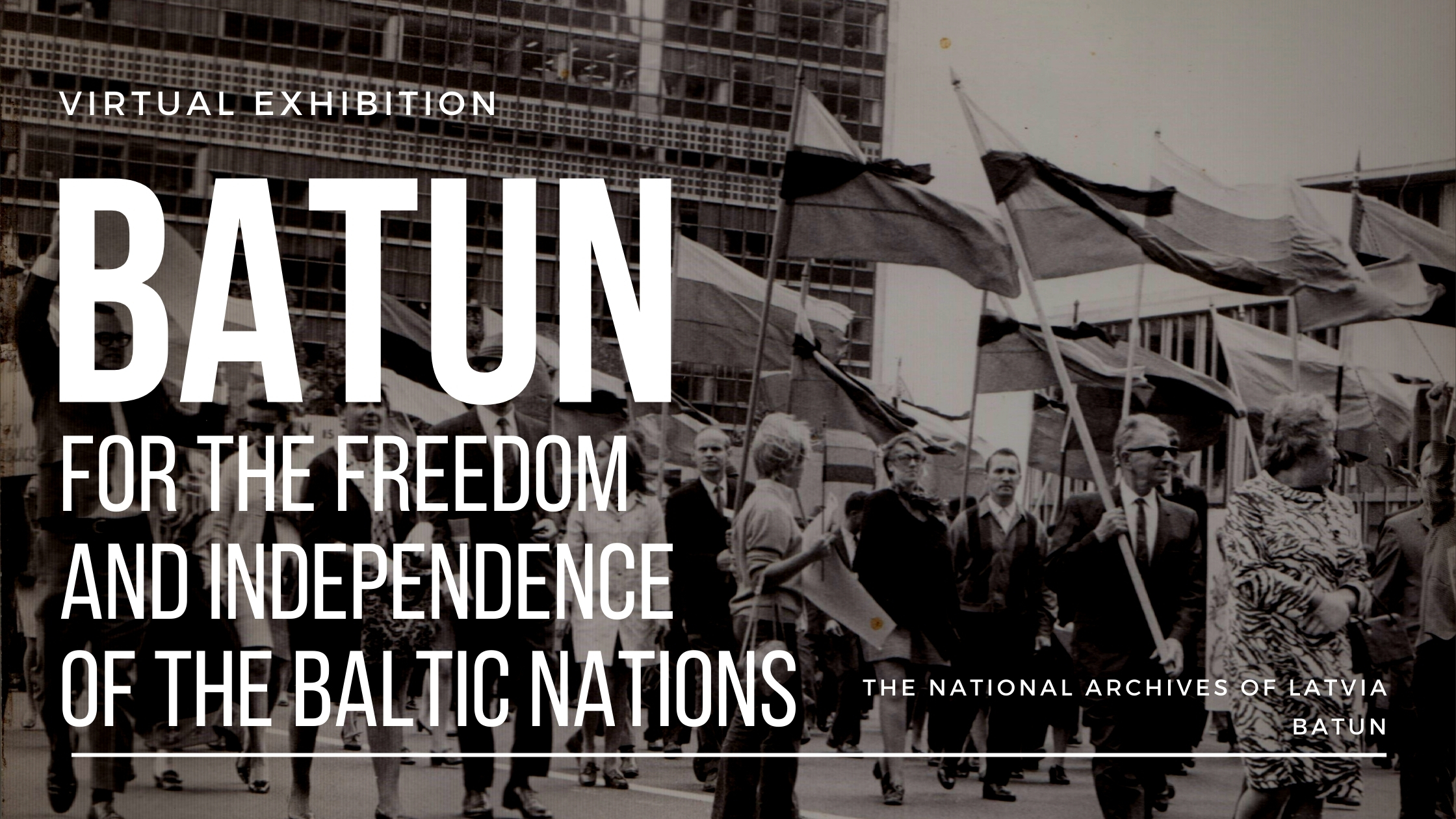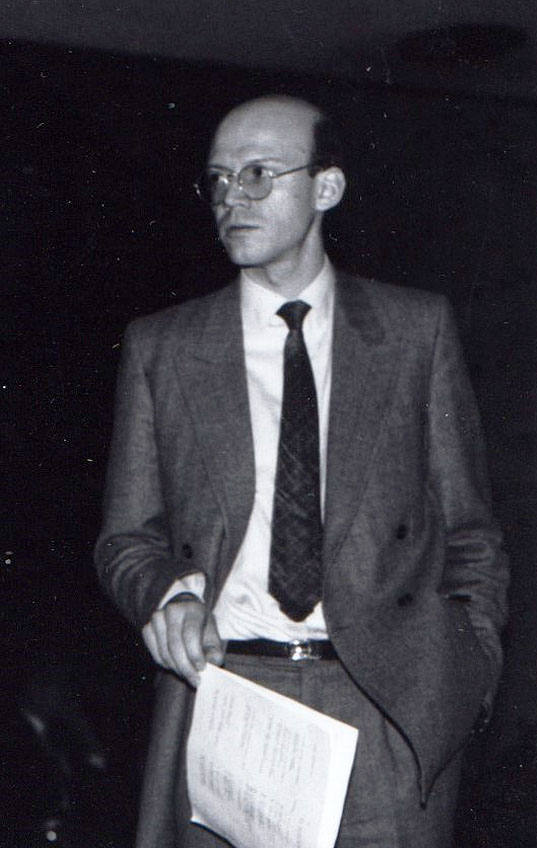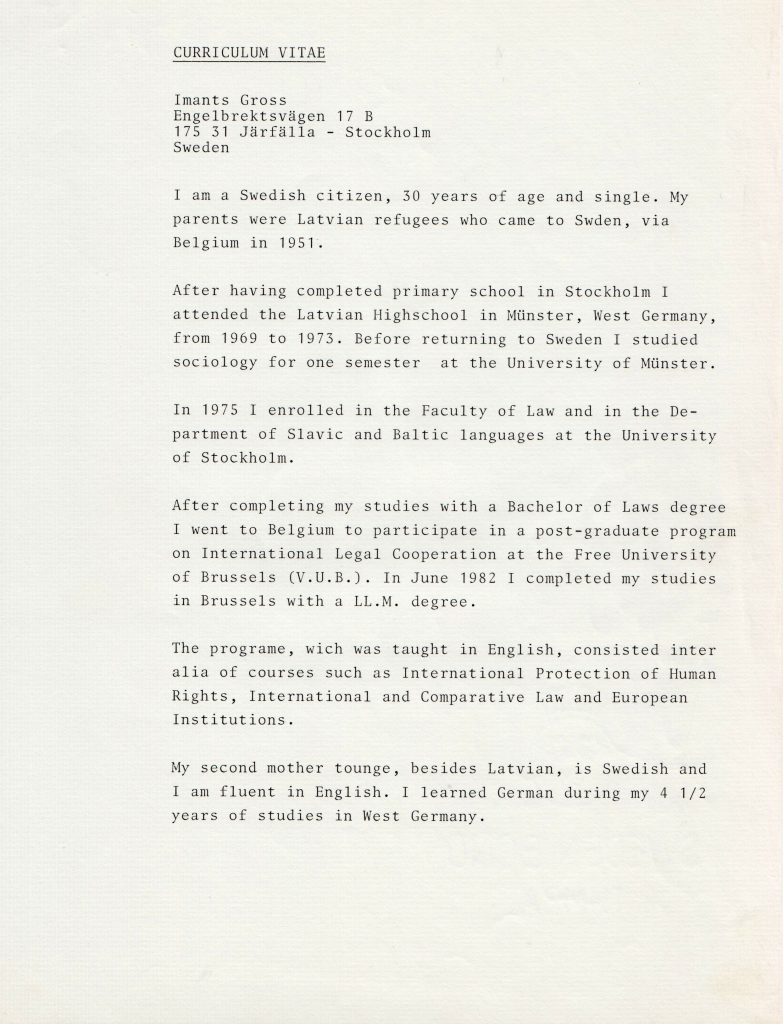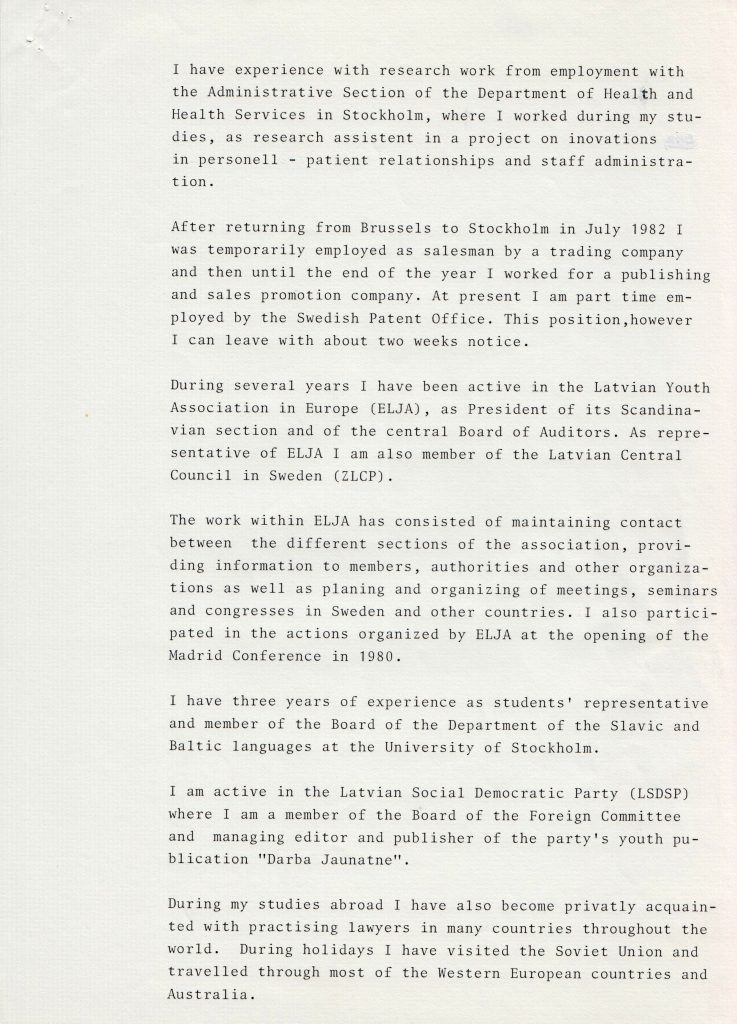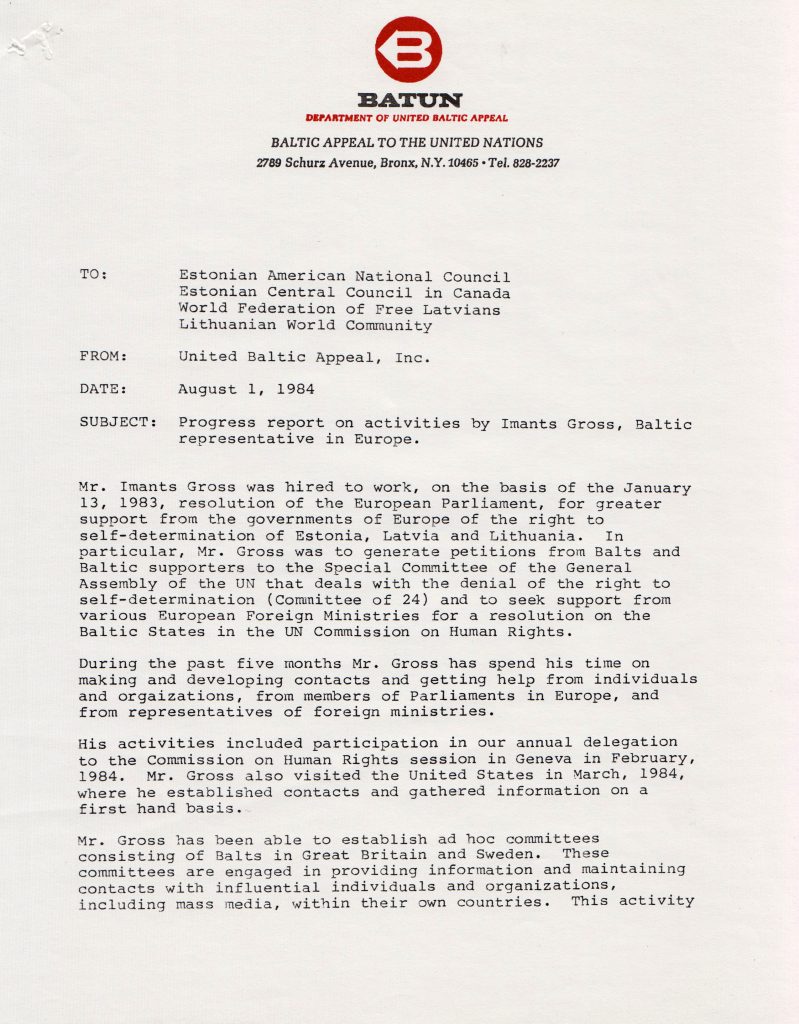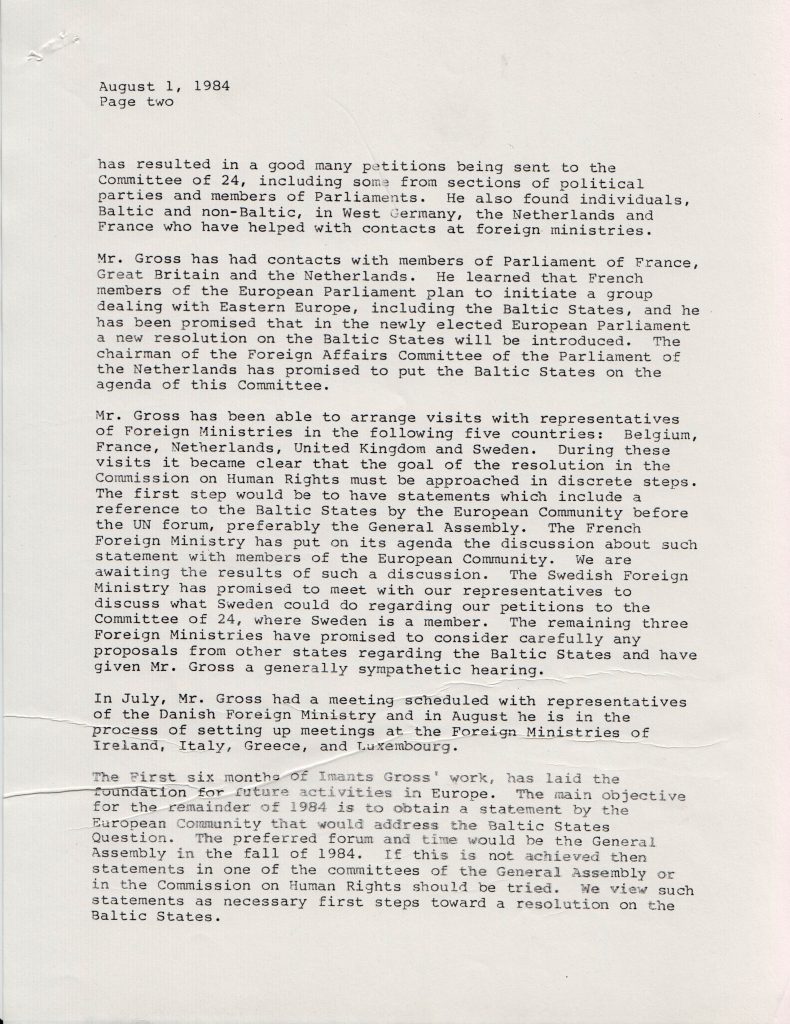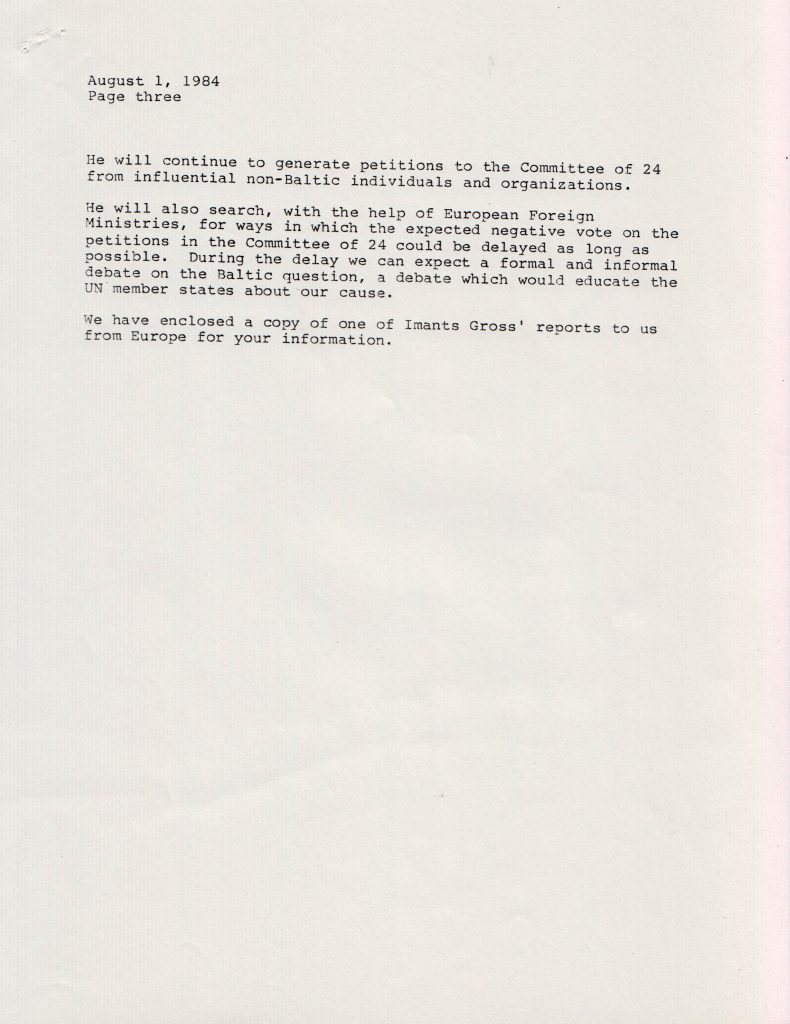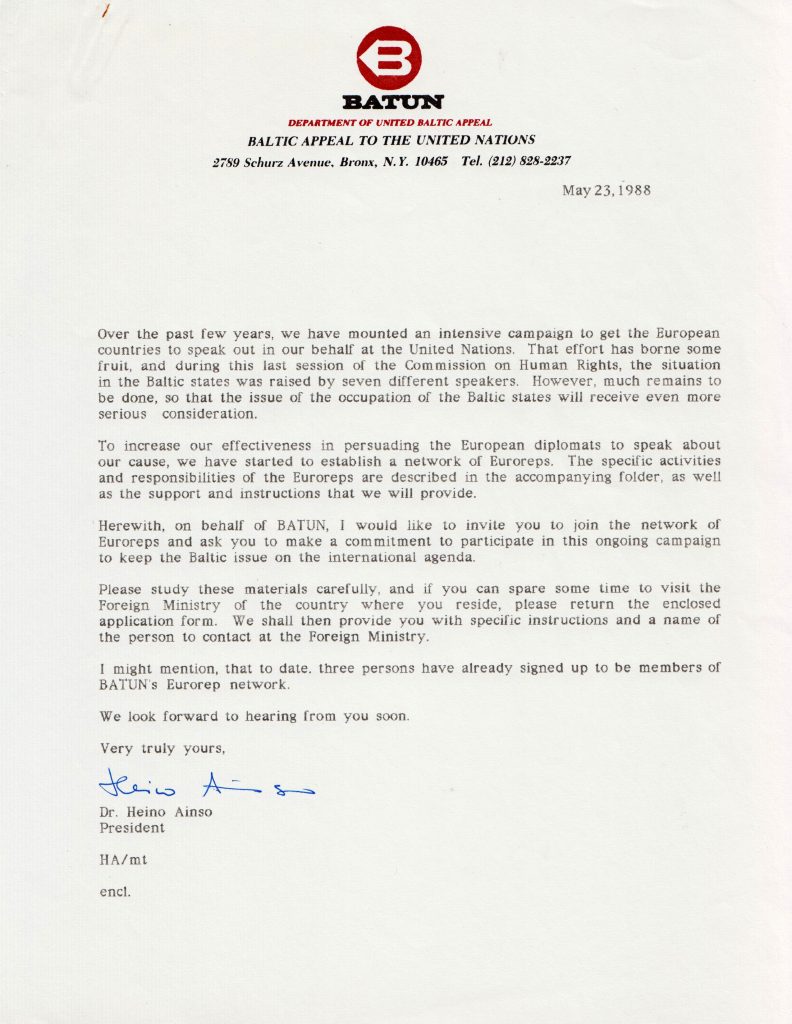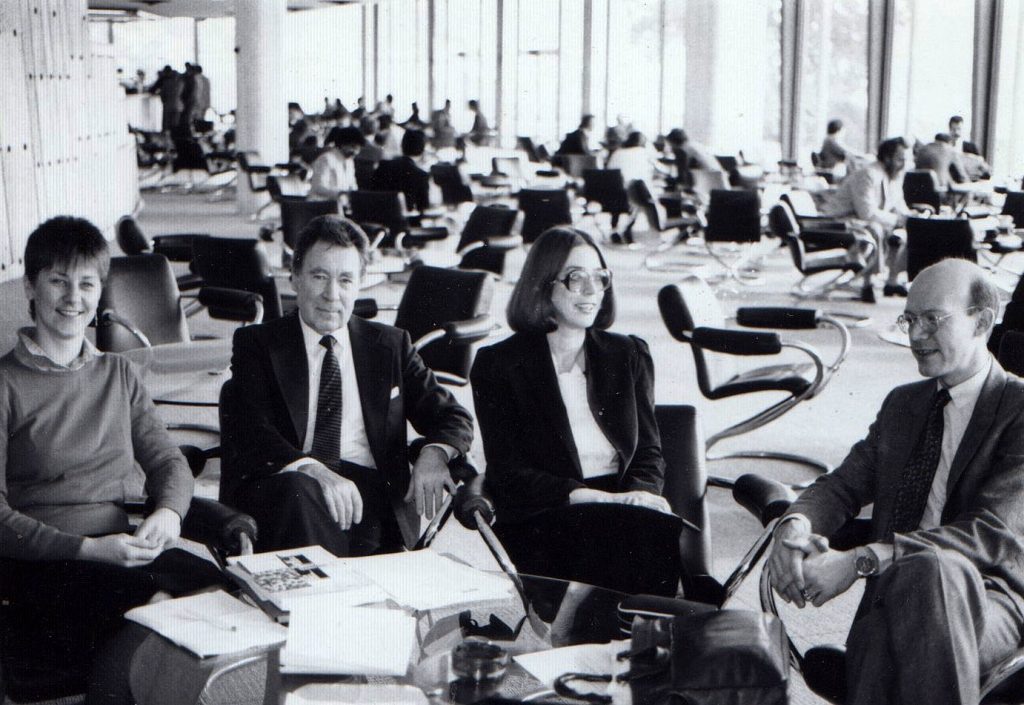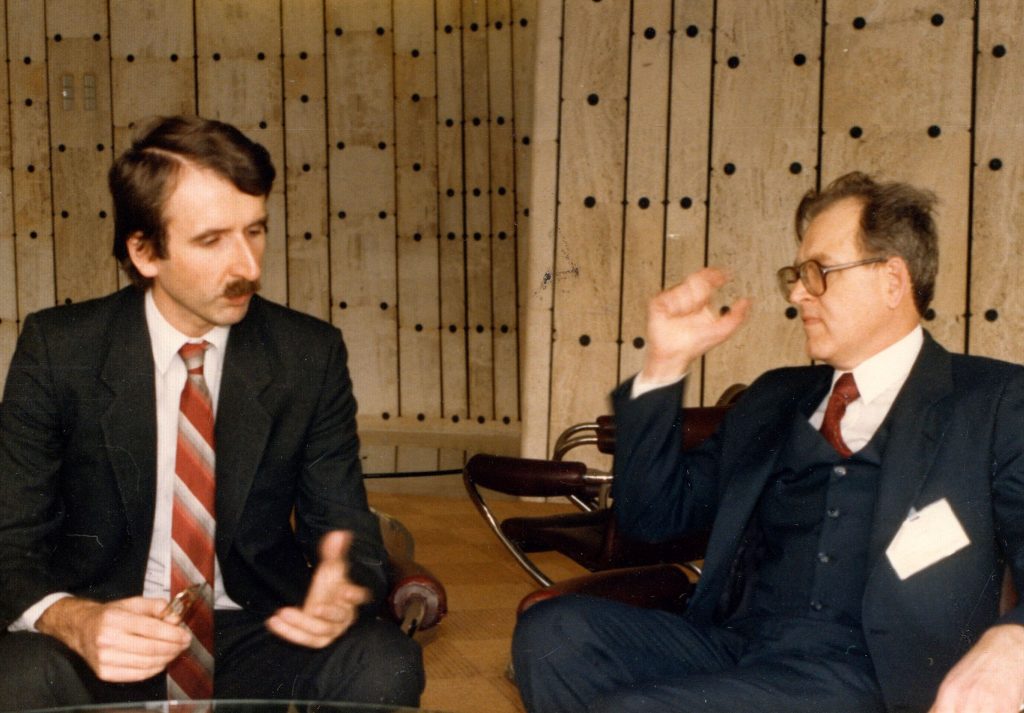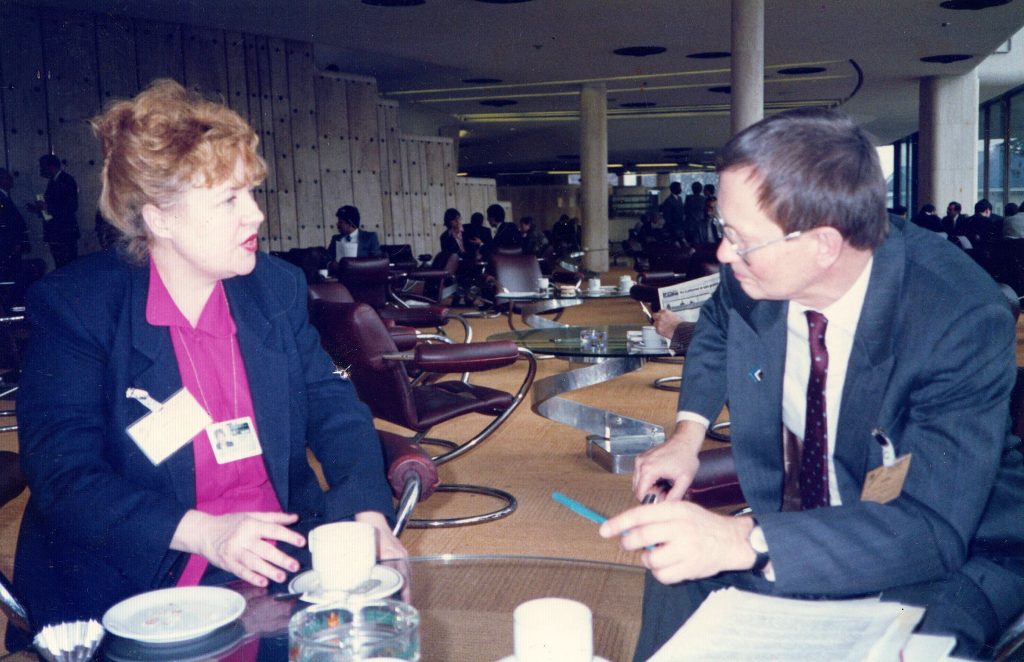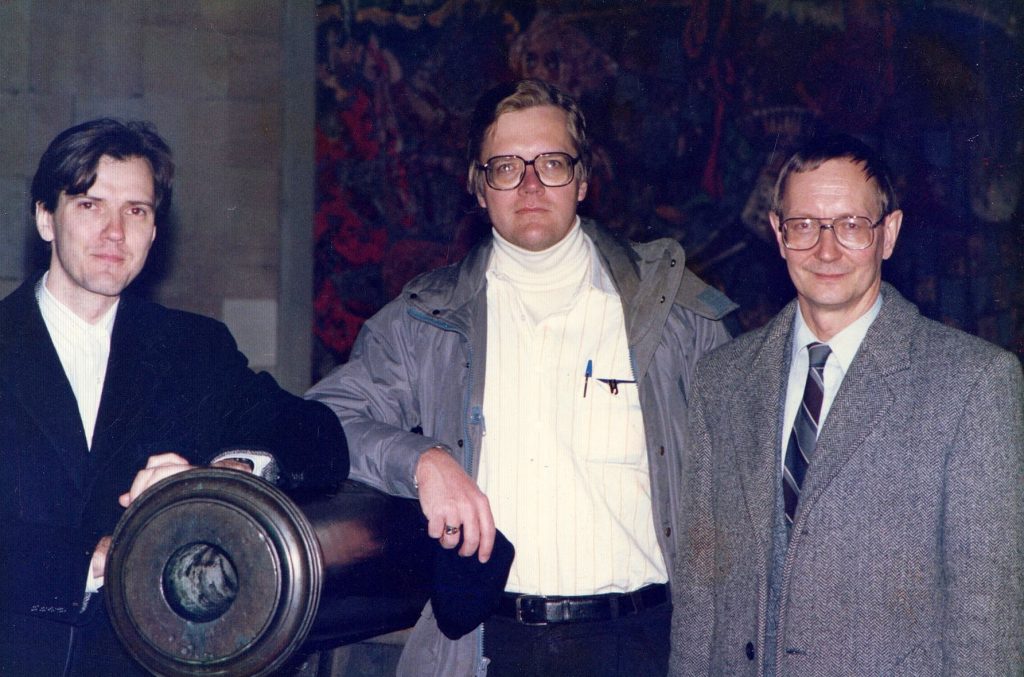The Europroject was a BATUN lobbying action that lasted from 1983 to February 1989. This period saw a greater number of visits to UN permanent missions than had been during any other period. The visits to Geneva became more productive, and visits to the European capitals were made for the first time. BATUN’s Europroject were related to the European Parliament resolution on the Baltic Question passed in January 1983, which was the response to the “Baltic Memorandum” signed in 1979 by 45 citizens of Soviet Estonia, Latvia and Lithuania. The 45 dissidents who signed the memorandum emphasized that the secret protocol of the USSR-Germany non-aggression pact of August 23, 1939 – the Molotov-Ribbentrop Pact – violated the national sovereignty of the Baltic states and that the world’s silence supported former, current and emerging aggressors. The resolution of the European Parliament on the Baltic States marked an important change in how the Baltic Question was dealt with internationally. For the first time, since the Baltic States lost their independence in 1940, an international alliance raised the question of their legal status and current situation.
In 1984, BATUN and its partner organizations expanded the Baltic lobbying capacity. They hired Imants Gross as a full-time lobbyist for Europe. Lobbying the European states was now done directly by meeting with officials from their foreign ministries, as well as indirectly, by Baltic and non-Baltic individuals, organizations and media in Europe who were contacted and motivated by Gross. During the fifteen months that he was working fulltime, which included fourteen months as BATUN’s European Director, and one month in August-September of 1985, when he again made between 15 and 17 visits to ten foreign ministries in Europe, and one visit with the representatives of the US Department of State. As a member of BATUN’s delegation to the annual session of Commission on Human Rights in 1984, 1985, and 1986, he made about 30 visits to meet with diplomats of several countries.
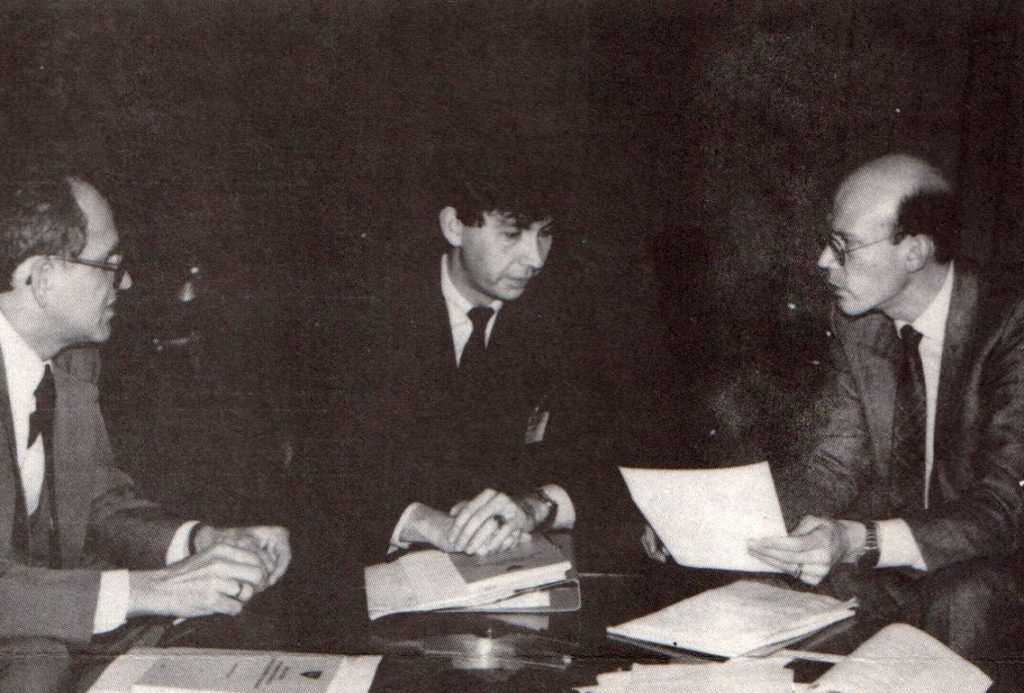
Dagmara Vallen’s audio interview with Imants Gross about his work at the foreign ministries in Europe, 1988 (in Latvian). Source: LNA LVA F.2579, A.3v, L.211.
BATUN also tried to organize the Euroreps, a network of volunteer lobbyist in Europe. The new lobbyists were used to directly lobby the permanent missions in the Commission on Human Rights (UNCHR) in Geneva during its annual sessions. They also mobilized to do BATUN’s indirect lobbying through Baltic individuals, organizations and media in North America and globally. The Euroreps began making their visits to the European foreign ministries in 1988, when four visits were made. The first Euroreps were Andres Küng, Jolanta and Maurice Gott, Imants Gross and Atis Lejiņš, as well as N. V. Morley-Fletcher, Guntis Bērziņš, and A. Vilcinskas, who were leaders of the Baltic Council of Great Britain. Also, there were Australiareps and Canadareps, Juris Liepiņš and Guntis Siliņš respectively. In New York during the summers of 1986-1988, the three BATUN interns–Albert Motivāns, Gytis Barzdukas, and Kaija Gertnere–also participated in the lobbying. The first two interns were shared with the Lithuanian Information Center.
During the Europroject, BATUN delivered a great deal of information to the UN Member States. This was done orally and in writing during visits in New York, Geneva, and the European capitals. BATUN attended seven UNCHR sessions during these six years and two months. BATUN delegations spent about 160 lobbying days in Geneva and during this time made about 200 visits to the States Members and Observers of the UNCHR and delivered hundreds of pages of information on the Baltic Question.
Petitions to the UN Special Committee on Decolonization
The lobbying campaign for petitions to the Decolonization Committee – proceeded primarily in two ways: in Europe through the efforts of Imants Gross and globally – through BATUN board appeals to exile Baltic organizations and media. The petitions requested that the Baltic States be included on the Committee’s list of Non-Self-Governing Territories to which the Decolonization Declaration is applicable. BATUN optimistically concluded that, even without formal acceptance, the petitions could serve to inform some of the many UN diplomats who were unaware of the Soviet occupation of the Baltic States. By sending BATUN’s petition materials in advance, the petitioners would be the EP and its members, local legislators, political parties, local Baltic organizations and prominent Balts, dissidents who have recently left the Baltic States, and others, including persons in the Baltic States. In October 1983, BATUN President Ints Rupners sent out letters urging Baltic organizations and prominent Baltic individuals to mail petitions in March 1984 in order to persuade the European Parliament and its members, as well as other legislators, non-Baltic organizations and political parties, influential non-Baltic individuals to also send out petitions.
In Europe some of the individual petitioners were parliamentarians: members of the European Parliament or national parliaments, anti-Soviet organizations, such as the Bukovsky Foundation, Assembly of Captive European Nations and others, mostly Baltic organizations, sent petitions. The total number of petitions that Gross generated directly or indirectly reached hundreds. A survey, after March 1984, probably between mid-year and Fall, of the number of petitions generated mostly by the efforts of BATUN’s board, reported that BATUN had received copies of or information about individual or group petitions signed by 1124 Balts. Also, non-Balts – organizations or churches, professors and academic staff members, several politicians and other prominent individuals in Australia and USA, had submitted petitions to Amadu Koroma, Chairman of the UN Special Committee on Decolonization.
The petition campaign gradually tapered off in 1985. Gross made the only extensive evaluation of the petition campaign as of the end of March 1985. He wrote the following, apparently expecting that the campaign would continue:
“…the UN Decolonization Committee… is dominated by … the Soviet Bloc and Third World, which together hold twenty-three of the twenty-five seats. With the recent departure of Australia, Sweden is the only Western state represented. Obviously, it would not be realistic to expect that the Baltic issue would receive objective or favorable treatment there… Nevertheless… the campaign can serve a useful purpose. To begin with, by demonstrating the international impact of a resolution of the European Parliament, it may encourage that body to take further action on the Baltic question. Several members of the parliament have in fact expressed their… satisfaction over the great response by Baltic émigré groups and have indicated that they are prepared to raise the issue again. In addition, the campaign may put increasing pressure on the European foreign ministers to raise the Baltic question in a more favorable UN forum, such as the [UNCHR]. Finally, the campaign can contribute to a broader awareness of the problem, in this case by the Third World members of the Decolonization Committee”.
Resolution in the Commission on Human Rights
Simultaneously with the petition campaign, BATUN also lobbied to get a UNCHR resolution on the Baltic States. This involved visits to the permanent missions in New York, some of the annual visits to the UNCHR session in Geneva, and Gross’ visits to the foreign ministries of Western Europe. BATUN’s efforts on behalf a UNCHR resolution were launched in late 1983. Juta Ristsoo’s proposal for a UNCHR resolution under the General Assembly’s either agenda item 9 – self-determination – or agenda item 12 – the violation of human rights – was included among the documents for the series of fifty visits planned for the period between December 1983 and the spring of 1984 in New York.
The views of diplomats visited ranged from skepticism to limited enthusiasm about the prospects of raising the Baltic Question as a human rights issue under agenda item 12. There was no support for raising the question under agenda item 9, i.e., self-determination. BATUN was able to get a statement on the Baltic States included in the draft of the European Community (EC) statement scheduled for November 22 in 1988 under the General Assembly’s agenda item 12. The first step occurred on November 9th, when the presiding officer of the EC dealing with Third Committee matters agreed to include the Baltic issue. The EC’s representatives on the Third Committee met on November 16 and decided to ask their Foreign Ministries to approve the statement on Baltic States. On November 21, a decision was made to remove the statement from the speech. One of the EC diplomats queried by BATUN about why the statement on Baltic States was removed, implied that the Foreign Ministries of the EC had rejected the statement because they felt it was premature and they had decided “to work out a common policy on the Baltic States.” In effect, the EC decision to formulate a Baltic States policy was one of several events that allowed BATUN to move on to its next lobbying period.
Please raise the issue of the Baltic States!
BATUN made a broad-based effort to get the UN Member States to speak about the Baltic Question. BATUN tried to get EC and individual Member States statements to be made in the General Assembly and its Third Committee, as well as Economic and Social Council. It also included getting Member States to intervene in discussions with Soviet diplomats on behalf of political prisoners. The efforts occurred against a background of many years of statements on the Baltic States by representatives of the US and sometimes other member states, in the General Assembly, its Third Committee, and in the UNCHR.
Carl Gershman (US Representative in the Third Committee of the 37th General Assembly) raised the Baltic Question on behalf of the US for the first time in October 1982. Gershman spoke at length and strongly about the violation of the Baltic States’ right to self-determination by the Soviet Union. On October 28, 1982 John D. Lodge (US Representative in the to the 37th General Assembly in the First Committee in Right of Reply to the Soviet Union) in his statement said the following:
…”Mr. Chairman, in conclusion, I cannot fail to note the fact that the Russian delegate is daring to criticize the United States this morning, this is most surprising, actually referred to the circumstances of the opening of World War II in 1939. Forty-three years is surely too short a time for any of us to forget the infamous Molotov-Ribbentrop Pact of August 1939. It was just after its signature on September 1 the Hitlerite Armies attacked Poland from the west, while from the east, Hitler’s Russian allies invaded the very same Poland whose right to solve its own problems Moscow asserts today. Let no one here forget that the next month, in October, Soviet troops with military bases rolled over the Baltic Republics of Estonia, Latvia and Lithuania. And finally, Mr. Chairman, let no one here forget the Soviet invasion on November 30, 1939 of gallant Finland, subdued only in 1940 by fourteen Red Army Divisions. All represent an interesting and instructive display of Russian concern for the principle of non-intervention”.
An example of something that can have maximum impact, is the events during the 1988 session of the UNCHR, when the United States circulated President Reagan’s letter “on victims of long-standing human rights abuses among them …the Baltic nations of Estonia, Latvia, and Lithuania…” as a UNCHR document and made a statement on self-determination.
The substance of the two US statements on the Baltic States:
“… the Baltic Republics of Estonia, Latvia, and Lithuania have been denied their right to self-determination for some fifty years; particularly cruel is that these small countries lost that right as the result of a deal made between Stalin’s Soviet Union and Hitler’s Germany. Stalin’s successors, for all their alleged repudiation of his abhorrent policies, have never rescinded the gains that accrued to the Soviet Union as a result of its cynical pact with Nazism“.
The US response to the USSR reply:
“We were not the ones that invaded and occupied the Baltic Republics…. Let us speak about the Baltic Republics, Mr. Chairman. These Republics fell into Moscow’s claws as a result of the Pact between Stalin and Hitler. As a consequence of the Pact, tens of thousands of citizens of those Republics disappeared in the Soviet Gulag. Over these past years, we have seen the KGB repress demonstrations protesting the Soviet occupation. We see activists such as Gunars Astra, Mart Niklus and Balys Gajauskas imprisoned in psychiatric hospitals, concentration camps, prisons or in exile. They speak to us about Micronesia. We would be happy to compare acts of self-determination carried out in Micronesia with any such acts in the Baltic Republics or in any other part of Moscow’s empire”.
The frequency of extensive contacts did not start to increase until the end of the period as perestroika/glasnost in the USSR started to attract attention globally. However, the extensive contacts did yield some usually positive feedback on the BATUN documents that the diplomats had read and indicated that diplomats who had previously been ignorant about the Baltic Question could be educated. Many promises were made to bring the documents to the attention of the respective delegation leaders or foreign ministers. In February of 1989, even the Soviet representative at the UNCHR, Mr. F. Stanewski, spoke favorably, and at length, about restructuring in the Baltic republics under the provisions of agenda item 9 (self-determination), including about the restoration of national symbols and the exercise of self-determination. However, the one topic he did not mention was the restoration of independence to the Baltic States.
